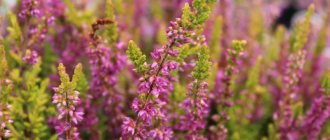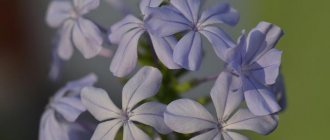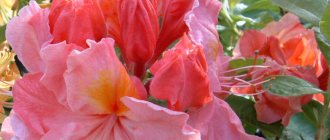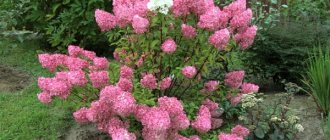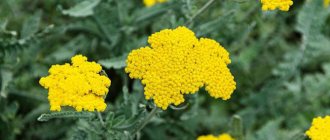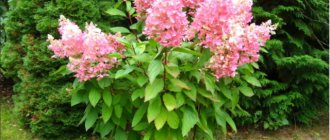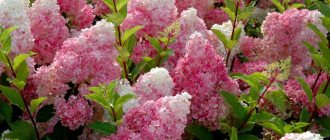Sorbaria sorbifolia is one of 4 species of deciduous shrubs from the genus Rowan and the Rosaceae family.
Its natural habitat is Northeast Asia and the Far East, from where the shrub quickly spread throughout Europe and North America as a popular and easy-to-grow garden plant.
Interestingly, the species used to belong to the genus Spiraea, which is why it is often called false spirea.
Fieldfare is unpretentious in care, resistant to severe frosts, immune to air pollution and substrate salinity, so it is ideal for planting in urban environments.
Origin and appearance
Fieldfare shrub (lat. Sorbaria) belongs to the Rosaceae family. The plant is found in many Asian countries.
The genus is represented by only 10 varieties of culture. The name that the bush has comes from “sorbus”, which means “rowan” in Latin. This name is due to the fact that the leaf blades of this crop are almost identical to mountain ash. The only difference is that the rowan leaf is usually somewhat larger.
Amazingly beautiful fieldfare flowers can be the best decoration for your garden plot
Fieldfare has been planted as an ornamental plant for quite a long time - approximately since the 18th century.
The plant is characterized by twisting gray-yellow stems. The bush itself can grow up to 3 meters. The flowers of the ornamental shrub form paniculate inflorescences in the form of a pyramid, consisting of a large number of small flowers. The latter can be white or cream in color.
Annual plants as part of a flower border
Annual plants live a short but vibrant life. In early spring, their seeds are sown in order to obtain seedlings. In the summer they turn into blooming bouquets, and wither in the fall. Every year the border of annual flowers will have to be renewed. But this is the only drawback, and it is completely offset by the advantages of a border of annual flowers.
Such plants, even purchased as seedlings, are inexpensive and bloom very beautifully. Even in the very fact of their annual renewal there is a positive hidden: you can create new beautiful combinations of plants. Below we give you a small list of the best varieties.
Marigold. Among the many varieties of these plants, preference should be given to low-growing border flowers. Marigolds bloom from June until the coldest weather. There are varieties of marigolds with double and simple flowers. A little shade does not interfere with their growth and flowering. Marigold seedlings are planted in mid-May.
Marigolds never look too simple: the plants are varied, attractive and not boring: there are both simple and double varieties
Nasturtium. This plant loves warmth and light. Nasturtiums planted ahead of schedule may freeze. Nasturtium cannot tolerate replanting, so it needs to be grown in peat pots. If the plant doesn't get enough light, it may stop blooming and growing. Moderately fertile and moist soil is ideal for nasturtium.
Nasturtiums will decorate the area both as border flowers, and in hanging baskets, and even just in decorative pots placed along the path
Verbena
It is important not to make a mistake and choose a low-growing plant. Verbena seeds can already be planted in the ground in April if they are covered with film on top. This drought-resistant and light-loving plant does not tolerate excessive watering.
This drought-resistant and light-loving plant does not tolerate excessive watering.
Verbena can be in union with marigolds and marigolds, but for rudebeckia and helenium they create a sharp contrast
Ageratum. Among annuals, flowers with such an amazing blue color are very rare. In order for the seedlings of this plant to be healthy, they need to be planted towards the end of March or early April. Ageratum blooms in June and fades only by September.
It is important not to plant the plant in the shade and not to over-fertilize the soil, otherwise there will not be sufficient flowering; overgrown ageratum can be cut
Iberis. In March-April, the seeds of this plant can be sown in the ground. You just need to place them at a certain distance from each other, because when replanting the plant often suffers. Read more about planting and care.
Iberis is usually planted in borders along with tall annual flowers: it creates a wonderful snow-white background that makes the garden elegant
Lobelia. This plant loves the sun. Its pink or blue flowers bloom in June, and abundant flowering continues until frost. Seedlings of these plants should be placed under glass.
Look at these flowers and think if you would like to have this amazing royal blue color in your garden plot
Cineraria. Undemanding and unpretentious, cineraria look gorgeous, but are very sensitive to waterlogging. In the shade, the wonderful silver shade of the plant can turn into ash gray. The plant reproduces by seeds.
This magnificent plant looks a little like coral and, like coral at the bottom of the sea, has a strong attractive power
Alyssum. Alyssum sown in early spring directly into the soil under the film will bloom 1.5 months after germination. Loves cool weather and emits a delicate aroma that attracts butterflies and bees.
The delicate aroma of this plant can attract bees and butterflies to it, and the fragile vulnerability of flowers attracts people's attention
There simply isn't enough space to display the many annuals that make great borders.
Fieldfare in the landscape
Rowan leaf, like chokeberry, is actively used in landscape design by both professionals and amateurs.
Tamarix shrub - description of species and varieties
Its white and beige flowers look very beautiful in any composition. The plant goes well with almost all flowers and shrubs. Most often, a shrub similar to rowan is used in the following cases:
- As the center of a flower arrangement surrounded by different flowers.
- As part of a hedge.
- As a companion to tall, large trees (it hides a long trunk with its foliage).
- In combination with all kinds of coniferous trees.
Important! Beekeepers give the rowan shrub a particularly high rating, since the plant is an excellent honey plant.
Planting and caring for the mountain ash shrub
This shrub is completely unpretentious to environmental conditions. But in order to ensure its fastest and most productive growth, it is worth knowing some of the nuances of planting mountain ash.
The shrub feels great both on the sunny edge and in the shade. The best choice would be partial shade.
Since this plant's main habitat is near large bodies of water, it needs moist soil. However, you shouldn't overfill it. This can lead to stagnation of water in the soil and lead to rotting of the roots.
Before planting the plant, it is recommended to treat the hole with organic fertilizers to help the bush take root and settle in faster.
To avoid stagnation of moisture in the soil, the plant should be provided with high-quality drainage: it will rid the bush of excess moisture.
Planting and caring for mountain ash is carried out with the arrival of a thaw. The hole for it should be no less than 40 cm deep. Since mountain ash is a shrub prone to rapid growth, this must be taken into account when planting it. The width of the hole should be dug from 60 to 80 cm. The more fertile soil you use, the more actively the shrub will develop in the future.
If your site is not rich in natural fertilizers, then before planting, be sure to add a layer of leaf soil, compost and peat to the hole.
When planting fieldfare bushes in open soil, it is important to protect the growth of its roots. This plant develops very quickly, and to prevent the unwanted appearance of new bushes, stick sheets of slate into the ground, thereby creating a kind of “fence” for the root system.
Pay attention to the photo of planting and caring for fieldfare bushes:
Caring for mountain ash does not require special skills or extensive experience in gardening. The main thing this shrub needs is abundant watering. Only with sufficient moisture will the plant develop properly.
If you do not have the opportunity to regularly water the shrub, then you can mulch the soil around the base of the roots with compost or peat. This will help retain moisture in the soil and prevent premature drying. But you can use this method only if you took into account the drainage system when planting.
The plant prefers light, breathable soil, so the soil needs to be loosened once a month. Try not to touch deep layers of soil so as not to damage the root system.
When planting and caring for fieldfare bushes, it is important to remember that this plant, although undemanding, responds well to the addition of fertilizers. It will be enough to add granular fertilizer to the soil, literally 2-3 times per season. Don't forget to remove spent blooms if you want to give it a neater look.
The plant should be pruned in the fall, before the first cold weather sets in. During this procedure, it is necessary to cut off the oldest shoots. When the plant reaches one year of age, you can begin to form a crown.
The soil around the mountain ash bush must be regularly weeded: it does not tolerate weed “neighborhood”. However, it is not worth disturbing the integrity of the soil at the base of the plant. Feeding is carried out superficially.
If you use fieldfare as an ornamental shrub as a hedge, then it is worth carrying out annual spring rejuvenation of the bush, leaving a height of no more than 1 m. The plant will bloom as before, regardless of pruning.
In addition to shoots, in order to maintain a decorative appearance, the shrub also needs pruning of inflorescences. This is done at the first thaw. However, it is worth cutting off only old, already faded inflorescences, cutting them to the largest bud. Thanks to this, it will take on a more neat appearance. After flowering, the panicles turn dark red and dry out.
By pruning you can adjust the size of the bush and its shape.
Fieldfare tolerates cold well, so there is no need to prepare it for winter.
Look at the photo of mountain ash in landscape design as a hedge:
Varieties for the middle zone
Red viburnum is a shrub or tree - description
Pallas and Sam varieties are suitable for planting in the climatic conditions of central Russia.
Pallas's Fieldfare
The variety grows in Siberia, the Far East, and also on the slopes of the Alpine mountains. This suggests that the plant is perfectly adapted to both harsh conditions and sudden temperature changes.
Rowan leaf does not grow too tall - up to 1.2 meters. It is characterized by a very lush round shape. The leaf plates are quite large - up to 15 cm, placed on the petiole in up to 15 pairs and have a dark green color. The inflorescences represent many white or cream-colored buds. Their diameter can be up to 1.5 cm.
Fieldfare Sam
The Sam variety has a round, compact shape and grows to a height of no more than 80 cm. The foliage of the shrub has a light green tint with a reddish or bronze tint. It blooms with white buds, which are collected in slightly elongated inflorescences. The stamens of the flowers are twice as long as the petals, which gives the shrub a particularly elegant appearance.
Cotoneaster brilliant - description
The most common plant of the Cotoneaster genus of the Rosaceae family is considered to be the brilliant cotoneaster (lat. cotoneaster lucidus). This deciduous shrub:
- It grows in the wild in China and the southern regions of Siberia. Prefers rocky slopes, pebble river banks, thickets of other shrubs and larch-mixed forests.
- Cultivated varieties are popular in gardens and parks throughout Europe and in the southern taiga zone.
- This cotoneaster is unpretentious in care and has a decorative appearance, tolerates pruning favorably, which is why it is often planted to create hedges and borders.
- In addition, the growth of the plant is slow - no more than 30 cm per year. The bush reaches its usual height only by the 10-11th year of life.
What does brilliant cotoneaster look like?
In a summer cottage, it is not difficult to recognize the brilliant cotoneaster:
- This is an upright growing deciduous shrub with densely pubescent young shoots of the current year. The height of the brilliant cotoneaster is about 2-3 m, and the diameter of the crown exceeds these figures by about 1.5 times.
- The leaf blade is pointed, ovoid or elliptical, 1.5 to 5 cm long and up to 3.5 cm wide. Smooth, dark green above, yellowish pubescent below. In autumn the color changes to purple, orange or red-brown.
- In May-June, loose corymbose inflorescences appear on the bush. Small pinkish flowers are located on the bush in such quantity that they almost completely cover all the leaf plates, attracting a large number of pollinating insects. Many people compare the bush during flowering to a lush pink cloud.
- For the first time, the brilliant cotoneaster bears fruit in the fourth year of life. They appear on the bush in late September - early October. They differ in spherical shape and diameter from 7 to 9 mm. Black and shiny, and the flesh is brownish-red. They stay on the bush until the first frost.
Cotoneaster brilliant - poisonous or not?
The black berries of the bush repel many novice gardeners with their appearance, who consider them poisonous. However, in the description of the cotoneaster shrub it is said that:
- The fruits of the plant are not poisonous, but have an unremarkable taste and aroma, which is why they are not used as food by people, animals, and birds.
- The lack of a pronounced taste and aroma allows them to be added only to table wines, liqueurs or some soft drinks to make them decorative.
- In folk medicine, cotoneaster berries are used to brew a decoction that helps treat ailments of the kidneys and excretory system.
Planting in open ground
Planting a shrub with leaves like rowan in open ground is not difficult.
What is needed for planting
All that is required to plant a crop in open ground is basic knowledge about the plant and its needs and the desire to grow a beautiful shrub.
Even a child can cope with planting fieldfare
Another point that you need to pay attention to is the correct choice of time for planting the bush. As a rule, planting should be done in early spring before the sap begins to flow or in the fall after the leaves have fallen.
Where to plant
Since fieldfare is a largely shade-loving plant, it should not be placed in open sunlight. The shrub will feel much more comfortable in the shade. That is why the crop is often planted under high villages.
As for soil, any type of fertile soil will do. The plant will feel equally comfortable both in damp and loose soil and in dense clay soil.
Planting step by step
Planting a bush in open ground involves performing a number of steps:
- Dig a hole in open ground about 40 cm deep.
- The bottom of the pit is covered with drainage material.
- A small amount of planting soil is poured onto the drainage.
- Nitrogen-containing fertilizer is added to the soil in the amount recommended by the manufacturer.
- A seedling is placed in the hole.
- Gently sprinkle the plant with soil and tamp it lightly.
- A neat hole is made near the trunk to prevent moisture from spreading when watering.
- Water the seedling.
Features and benefits
The shrub, which belongs to the Rosaceae family, has a number of features that must be taken into account when purchasing a seedling; significant ones include:
- Frost resistance. The plant can withstand frosts down to -30°C. In the frosty winter conditions of the northwestern region, protection is required in open ground - covering with spruce branches.
- The growing season begins in early spring.
- Field ash grows well in moist and infertile (sandy) soils. Although the adult plant is considered light-loving, it also grows well in partial shade. The bush does not tolerate drought well, losing its decorative properties; in extreme heat it needs watering.
Fieldfare is a real gift for beginning amateur gardeners. The plant quickly sprouts and grows successfully not only in rural areas, but also in urban environments (annual growth is up to 10-12 cm). It tolerates replanting well and annual spring pruning carried out for sanitary and rejuvenating purposes.
Sapling of mountain ash
Although in nature fieldfare can also reproduce by seeds, it is quite difficult to grow it at home. A faster and more productive method of propagation is by cuttings (root or shoots). The plant is cultivated due to a number of positive qualities:
- Graceful feathery leaves and large inflorescences make the shrub suitable for decorative use.
- Abundant and long flowering make fieldfare a valuable honey plant.
- The plant contains many useful substances, including vitamins C, P, essential oil, and tannins. Preparations based on fieldfare have medicinal properties: antiseptic, antibacterial, antirheumatic. The shrub is widely used in folk medicine as an astringent, tonic and regulating metabolic processes.
- The shrub can be used to strengthen the soil on slopes and areas with sandy soil.
See also: Catalog of companies that specialize in designing and performing landscape work of any complexity
Decorative options
Reproduction of fieldfare
Most often, fieldfare is propagated in one of the following ways:
- cuttings;
- from layerings.
The easiest way to propagate fieldfare is by cuttings.
Cuttings
The description of propagation by cuttings does not involve particularly complex manipulations. Therefore, the method is used in practice more often than others. Cuttings are taken from strong woody stems. Their length should be 20-30 cm. For rooting, the cuttings are planted in a container with soil. Next, all that remains is to carefully ensure that the soil remains moist throughout the entire process of rooting the future shrub.
Important! You can understand that the rooting of the cuttings was successful by the beginning of the growth of the tops.
From layerings
Propagating fieldfare from layering is quite easy. To do this, in the spring, take a long and (necessarily!) completely healthy stem. It is carefully bent to the ground so that the buds are in contact with the ground. In this position, the stem is fixed by covering it a little with earth. It is very important that the top is on the surface. After a while, the cuttings will take root; at the end of summer, they will need to be cut off from the mother plant and replanted.
Fieldfare shrub does not create any particular problems in terms of planting and care. In order for the cultivation to be successful and the plant to begin to bloom, you need to follow some rules regarding watering, feeding and preparing the plant for winter.
Diseases and healing properties of fieldfare
The fieldfare bush is resistant to diseases and harmful insects. However, its main enemy remains the green aphid. It feeds on the sap of the bush, which causes the foliage to dry out. Spider mites can also damage greens. A solution of fitoverm at the rate of 30 ml per 10 liters of water will help control harmful insects. Among the folk methods of fighting aphids, it is worth highlighting infusions of dandelion, garlic and onion.
If yellow spots appear on the foliage, this is the first sign of viral mosaic. Unfortunately, it is impossible to cure a plant from this disease, so if it is severely damaged, the shrub should be disposed of.
Pay attention to the photo of a healthy fieldfare bush:
Fieldfare is known all over the world for its healing properties. Its leaves contain a high concentration of flavonoids. Used in the treatment of rheumatism. Tinctures and aromatic baths are made from the inflorescences. The roots of the plant are used to prevent tuberculosis. Tea from the inflorescences helps fight throat diseases such as sore throat.
Look at the photo of the mountain ash. This is what is most often used in folk medicine:
Care
Watering
Fieldfare is an unpretentious plant and is easy to care for. But it cannot do without regular watering. The culture does not tolerate drying out very well. It is especially important to moisten the soil immediately after planting.
On average, a bush needs two abundant waterings (2 buckets of water for each bush) within a month. If the summer is hot and dry, it is recommended to double the number of procedures performed.
Important! It is recommended to water young plants more often than mature ones. They require more water to grow.
Top dressing
Fieldfare vitally needs regular application of organic fertilizers to the soil. You can add organic matter directly to the surface of the tree trunk circle in small portions.
Among the mineral compounds, the bush needs nitrogen, potassium and phosphorus. It is allowed to add useful elements to the soil in the form of granules without first dissolving them in water. For 1 square meter of planting, 20 grams of universal mineral-containing fertilizer is sufficient.
During flowering
The plant does not require any special care during the flowering period. It is enough to ensure that the soil directly under the bush never dries out, and from time to time (as it dries) remove wilted inflorescences.
At the end of flowering
After the fieldfare has completely bloomed, all inflorescences and fallen leaves are removed. The number of waterings is reduced to a minimum.
Preparing for winter
Due to the high level of frost resistance, fieldfare does not need to be prepared for the winter period - it can withstand even the most severe frosts without insulation.
Fieldfare is a very beautiful and easy-to-care plant.
Popular varieties of mountain ash: photo and description
The most popular varieties of fieldfare are felt, tree-like and the most common - rowan-leaved.
Felt fieldfare came to us from East Asia. Its main habitat is mountain slopes. Can grow up to 6 meters in height. Does not bloom and is not frost-resistant. It is the worst choice for site decoration.
Tree-like shrub , like the previous species, comes from Asia. Blooms throughout the summer season. Despite its resistance to cold, this species grows very slowly.
Mountain ash - the most popular variety.
It grows most often near rivers and large lakes. Unlike other species, it rarely grows more than two meters. It has a wide, straight crown. New branches have a green tint and gradually darken. The foliage changes color depending on the season: if in the spring it has a soft pink color, then by autumn it becomes a rich burgundy color. White color. Easily tolerates cold. It takes well to pruning and replanting. The most decorative species among all representatives.
There is also a variety of rowan-leaved fieldfare - the "Sam" variety.
It's like a smaller copy of the main view. The maximum height that “Sam” reaches is one and a half meters. Its leaves are smaller, and it does not grow as actively as its rowan-leaved relative. Despite its compact size, this variety is brighter and more saturated in foliage colors. Purple and red are also added to the primary colors.
Foliage is the main advantage of “Sam”. After all, it blooms almost imperceptibly. However, faded inflorescences do not spoil the decorative component of the shrub and do not need to be removed, since their number is significantly less than that of the main species.
Like its closest relative, “Sam” tolerates cold well and is not at all picky about soil conditions.
